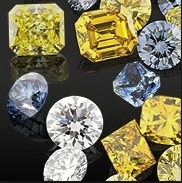Articles and News
GIA Says No Flood Of Synthetics Here | October 30, 2013 (0 comments)

Carlsbad, CA—Despite dire warnings from multiple trade sources about recent sharp increases in synthetic diamonds being slipped undisclosed into parcels of natural melee, executives at GIA (Gemological Institute of America), say there has been not been a flood of synthetics coming through its labs.
“We generally do not discuss details of the stones that come through the [GIA] labs, but we have seen no appreciable upturn in the number of synthetics, disclosed or not, submitted for grading,” says GIA public relations director Stephen Morisseau, recalling an earlier statement from Tom Moses, GIA senior vice president of laboratory and research, in an article on the GIA website. The controversy over undisclosed synthetics is centered on smalls (under 0.30 ct. sizes), as most luxury jewelers routinely obtain grading reports for larger stones, and those reports would identify synthetic or natural origins.
There are two main types of synthetic diamonds: carbon-vapor deposition (CVD) and high pressure, high temperature (HPHT). HPHT-created stones tend to be fancy yellows or yellowish browns, while colorless synthetics are typically produced by the CVD method, which produces Type IIa stones that contain no yellow-producing nitrogen.
GIA can readily identify both types, even if they have been treated post-production, Morisseau told The Centurion. Meanwhile, Stephen Lussier, executive vice president of marketing for the De Beers Group, maintains the high production costs of creating quality colorless CVD melee negates any price advantage the stones would have over naturals. The GIA article hypothesizes those stones that have shown up are byproducts of CVD-grown diamond material created for optic or electronic use.
But as production methods improve, that cost structure could change. Older CVD stones often initially came out gray and required extensive post-production heat treatment to remove the gray color, while recent CVD production shows no signs of post-production treatment.
At present, GIA officials see no reason for alarm. Speaking at a panel discussion at the 2013 Centurion Scottsdale show, Dr. James Shigley told Centurion attendees that undisclosed treated natural stones still are a far bigger concern in the U.S. luxury jewelry marketplace than undisclosed synthetics.
Whether it’s to catch synthetics or undisclosed treated naturals, the best course of action for luxury jewelers is to insist on warranties from all vendors, and drop any vendors who aren’t willing to guarantee their supply.
Top image: diamondsourceva.com







